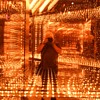Posted 8 years ago
 rniederman
rniederman
(346 items)
In looking into the beginnings of photography soon after its invention, I am truly amazed at how quickly it spread to the farthest corners of the world just after its 1839 announcement; and even more so as I broaden my research and camera collection to include early daguerreotype viewers and stereoscopes.
The origin of the first practical photographic process started in France and was not universally embraced as it is today. As with most inventions and innovations, photography had its share of skeptics and, for a brief time, scorn rained down on Louis Daguerre’s 1839 announcement. Regardless, due to pent up public interest after the April 19th announcement in Paris, photography quickly made its way to Britain, Germany and crossed the Atlantic to the United States. Samuel Morse recognized the importance of Daguerre’s achievement in a letter to the inventor on May 20th. He subsequently learned the process and taught others.
Evidence of photography’s incredibly fast ascension to a global level is also seen in remote countries such as India as early as January 1840. Commercialization of the country’s photographic trade was assisted by the government and by the 1850s it was no longer considered a novelty.
This rare 1850s viewer with original daguerreotype image pair made by F.W. Baker of Calcutta is an example of India’s maturing photographic industry. Baker, after moving to Calcutta, was first employed as an assistant in 1855. By 1857 he established a studio and advertised it as “Baker’s Daguerrian Room” noting the availability of “Stereoscopic likenesses in Claudet’s patent folding cases.”
This fine dark maroon leather covered folding viewer is based on a design patented by French photographer Antoine Claudet (#711, March 23, 1853). It is distinctive and important because, unlike other folding viewing cases, the lenses are mounted in a thin leather covered enclosure which springs out an inch (or so) to more comfortably view the image pair.
The stereo daguerreotype of an anonymous well dressed gentleman and lady is not a great composition, only technically adequate, and lacks intimacy. Could this be a brother and sister? On the other hand, the stereo pair has nice artistic qualities. The photographer / artist painstakingly hand-tinted both images to be identical in appearance. If you think about it, tinting had to be done correctly the first time; coloring errors were not reversible and it took a lot of skill to keep from potentially ruining the images.
The woman’s wonderfully lavish dress is made more striking with careful hand-tinting using a pink dye. The artist also had a light-handed deft touch in delicately tinting exposed skin (arms and faces) for a natural look; something that is usually overdone.
Oh ... and a bit of trivia for those of you who got this far into this post ... the first successful daguerreotype in the United States, an 8 to 10 minute exposure of New York’s St. Paul’s church, was made by a local resident, D.W. Seager, on September 16, 1839. It was a remarkable event because the process was made public only a short time before then!














































Fascinating stuff! [;>)
Great information and history thanks for sharing.
Another wonderful piece!
Thanks for sharing your outsanding collection and great knowledge in early photography :-)
Wonderful acquisition!
Thanks for posting the stereo pair! I love getting the full effect (via the cross-eyed method)!
Great post !!! Love this !!!
Thanks!
NevadaBlades
Caperkid
I am impressed that the image is just as sharp to my eye as anything today, and the the couple are so attractive. It makes your eyes just want to stare into the image longer than you usually would. I am fascinated!! Bravo!
Hi PCC ... you are correct that the image is very sharp. Daguerreotypes are pictures created directly on the surface of a silver coated copper plate. You pretty much get the full resolution of the lens because there is no intervening negative. Each dag is unique unless photographically copied. Even to this day, it is difficult to rival the tonal subtlety and detail of a well made daguerreotype. Unfortunately this comes with several drawbacks; mainly images are very fragile, can tarnish, and difficult to view due to its mirror-like characteristic. Otherwise, glad you enjoy the image.
I only have 1 dag, A boy and girl ,and the girl has a rabbit on her lap. The bunny moved his ears some, and that part was blurred--but it was an amazing photograph. Now 40 years since I got it, it is too dark to see very well. No matter, because the image has been indelibly registered on my brain,-- I loved it so--and I can see it in my mind's "eye" even as I type this!!
Oroyoroyisthatyourhorse ... funny about showing the link to the lens. However, you're right. These are not inexpensive. Have you looked at my other stereo dag case posts?
http://www.collectorsweekly.com/stories/169537-stull-daguerreotype-viewing-case-c-1855
http://www.collectorsweekly.com/stories/178056-mascher-stereo-daguerreotype-viewer-with
Oroyoroyisthatyourhorse ... appreciate all the 'loves' over the years! I didn't know your name changed.
Thanks!
valentino97
inky
fortapache
kyratango
Thanks!
Thomas
Michael
TassieDevil
Thanks!
David
John K
shughs
Thanks!
Grandval
BB2
ravage60
Open the second picture to see it full size, cross your eyes and see the 3d effect!
Thanks!
Efesgirl
Oroyoroyisthatyourhorse
PostCardCollector
vetraio50
Wow, this is fabulous! I've never seen one before, had no idea they existed but now I want one!
I love the photo, so crisp - makes me wonder who they were and what the occasion was.
Thank-you for sharing your knowledge - off to see what else you have shared!
Thanks!
pops52
Rick55
pw-collector
Manikin
Thanks!
mcheconi
trukn20
mtg75
Thanks!
Celiene
Sean
Thanks!
Poire
SpiritBear
courtenayantiques
Thanks, Longings!
Thanks!
Poire
Beachbum58
Thanks!
crswerner
Neighborguysfan
Thanks!
NanaM
iggy
egreeley1976
Thanks!
sugargirl
fortapache
Thanks, AntigueToys!
Beautiful image!
scott
Thanks, Scott!
Thanks!
Manikin
sanhardin
Thanks, vintagegirl66!
Thanks, Phonoboy!
Thanks, Brett!